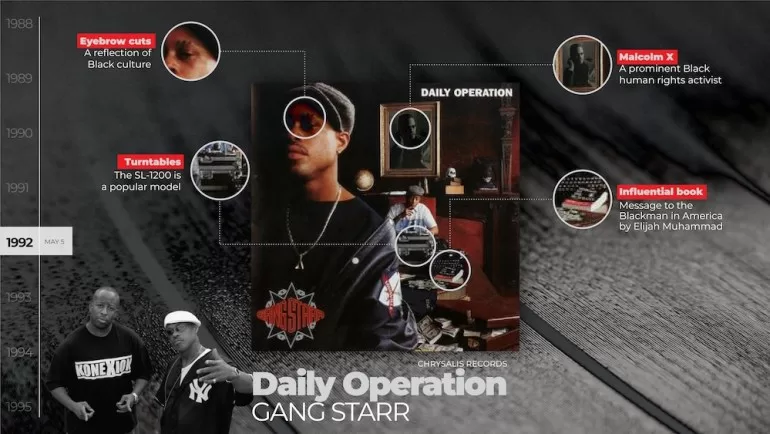Before streaming came to dominate the modern music ecosystem, fans would flock to record stores to flip through the latest releases. While CDs might now be relegated to a single stand inside a supermarket, for previous generations, record stores comprised a path to finding new music, a bit like searching through Spotify or Apple Music today.
Album covers were an important part of this experience. And in the world of hip-hop, they have long been used to send messages about culture, politics and the artists’ general worldview.
Here, Al Jazeera decodes eight album covers from the peak era of political hip-hop and explains the images and symbols used on each.
Gang Starr, Daily Operation (1992)

Eyebrow cuts: Pictured in the foreground on this cover of Daily Operation is Guru, who along with DJ Premier, forms the hip-hop duo, Gang Starr. The cuts shaved out of Guru’s eyebrows reflect an expression of Black culture that was popularised by rapper Big Daddy Kane.
Malcolm X: In the background hangs a portrait of Malcolm X, a Muslim American minister and human rights activist who had a significant influence on the world of hip-hop. Many of his speeches were cut and remixed in songs throughout the 1990s.
Turntables: These are SL-1200 turntables, among the most popular pieces of equipment used by hip-hop DJs. Gang Starr’s DJ Premier is one of the most prolific and influential producers in the industry.
Influential book: The book, Message to the Blackman in America by Elijah Muhammad, who was a prominent Nation of Islam leader, was first published in 1965. It introduced many in the world of hip-hop to Black theology, encouraging the principles of self-determination and community revitalisation.
Boogie Down Productions, Ghetto Music: The Blueprint of Hip Hop (1989)
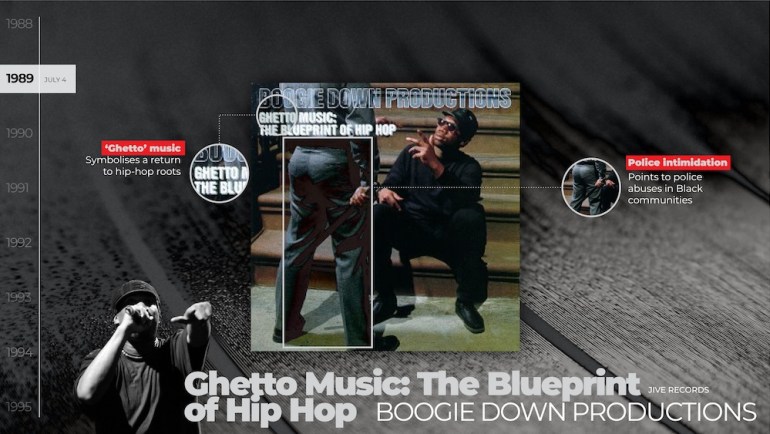
“Ghetto” music: The use of “ghetto”, a term used to describe poor African American neighbourhoods, is intentional. This is explained in the album’s liner notes, which denounce materialism in the industry, stating: “We’ve found it again necessary to return to our roots – ‘The Ghetto’ – to ensure purity, talent and intelligence often lost in trying to keep up with the Joneses.”
Police intimidation: The image of a police officer standing over group member KRS-One suggests a looming threat. The track “Who Protects Us From You?” is an indictment of police abuses in Black communities. The same year this album was released, the notorious Central Park Five case unfolded, in which five teenagers were wrongfully convicted of raping a white woman.
Queen Latifah, Nature of a Sista’ (1991)

Arabic name: Queen Latifah chose her moniker from an Arabic book of names – “Latifah” means “kind” and “gentle”. The word “queen” was added to represent the notion of women as queens of their own destiny.
Afrocentric attire: The focal point of this cover is Queen Latifah’s African-inspired headdress, which speaks to the Afrocentric themes that were popular in hip-hop of the 1990s. Many artists in this era used symbols to represent pan-Africanism and Black nationalism, including medallions and clothing decorated with images of the African continent.
X Clan, To the East, Blackwards (1990)
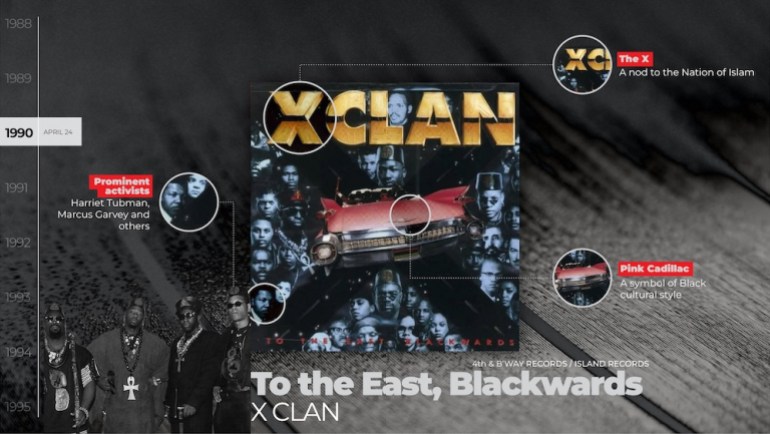
The X: This is a nod to the Nation of Islam practice of substituting an “X” in place of a surname (such as Malcolm X), which was symbolic of African Americans losing their true names and identities during the era of slavery.
Prominent activists: Members of the X Clan are pictured alongside prominent Black activists and abolitionists who fought for African American rights, including Harriet Tubman, Malcolm X and Marcus Garvey, among others.
Pink Cadillac: The pink Cadillac was symbolic of Black cultural style and upward mobility. Group member Professor X, who died in 2006, said the pink Cadillac was a message that people should “celebrate themselves”, adding: “When I think of a pink Cadillac I think of my uncles, who were from South Carolina. Those guys had a Caddy every year. It meant something to them. We were talking about a 1959 pink Caddy because it represented a point in time.”
Public Enemy, Muse Sick-n-Hour Mess Age (1994)
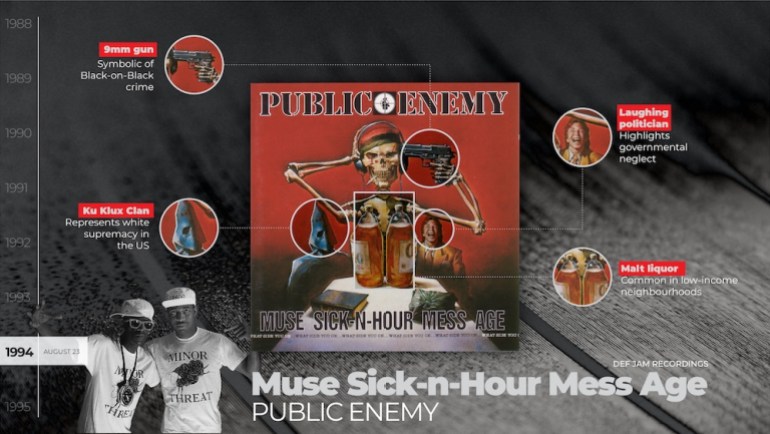
9mm gun: The image of a 9mm handgun pointing directly towards a skull is symbolic of Black-on-Black crime, suggesting that this type of violence is self-destructive or suicidal.
Laughing politician: This picture highlights governmental neglect of Black communities in the US. Public Enemy has been known to use provocative and hard-hitting political imagery. At the time of this album’s release in 1994, hip-hop was going through a transformation from Afrocentric political commentary to what Ice-T called “reality rap”, also known as “gangster rap”.
Ku Klux Clan: This picture of a hooded Klansman represents white supremacy in the US. It is notable that the Klansman is passively witnessing the destruction of a skeletal figure, presumed to be Black, as represented by the red, black and green kufi on the skull.
Malt liquor: The two bottles of 40-ounce malt liquor point to the prevalence of this substance in Black neighbourhoods, as the cheap alcoholic beverage has been marketed towards low-income communities.
Ice Cube, Death Certificate (1991)

American flag: The country’s flag is draped over the corpse, reinforcing the album’s criticism of the US, with songs addressing issues such as gun ownership, racial profiling and the “war on drugs”.
Uncle Sam: On this album cover, rapper Ice Cube is pictured standing over a corpse lying on a gurney with a toe tag that says “Uncle Sam”, which symbolises the US government. This points to how American institutions have failed the citizenry.
Common, Like Water for Chocolate (2000)

Point of view: The image appears to have been shot through a car window, highlighting how American society passively views the racist societal structures designed to oppress Black citizens.
Racial segregation: This cover image was shot by photographer Gordon Parks in Mobile, Alabama, in 1956. It clearly captures the racial segregation of the era, with a Black woman drinking from a water fountain labelled “coloured only”, as a young girl peers into a nearby shop window.
KMD, Bl_ck B_st_rds (2000)
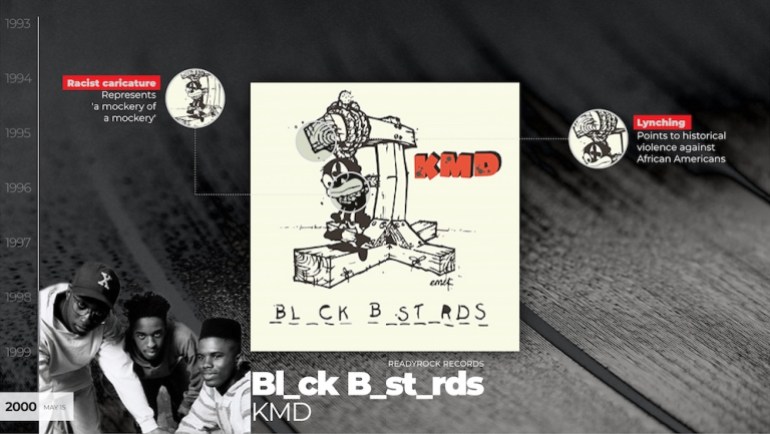
Racist caricature: The “Sambo” caricature has traditionally been used as a racist depiction of African Americans, but on KMD’s album cover, it makes a statement against racism. The image of this character being hung represents the removal of racist stereotypes and negative depictions of African Americans. “It was a mockery of a mockery,” group member MF Doom, who died in 2020, once said.
Lynching: The imagery of lynching, represented by a hangman’s noose, points to the historical violence perpetrated against African Americans. Lynchings were used to terrorise and silence Black people in the US during the 19th and 20th centuries, especially across the southern states.
